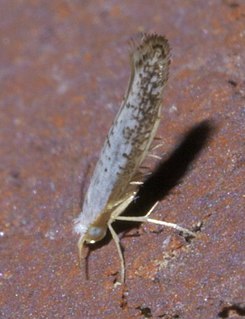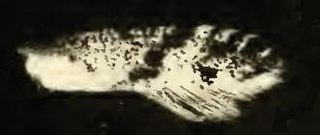| Argyresthia annettella | |
|---|---|
 | |
| Wing | |
| Scientific classification | |
| Kingdom: | Animalia |
| Phylum: | Arthropoda |
| Class: | Insecta |
| Order: | Lepidoptera |
| Family: | Yponomeutidae |
| Genus: | Argyresthia |
| Species: | A. annettella |
| Binomial name | |
| Argyresthia annettella Busck, 1907 | |
Argyresthia annettella is a moth of the family Yponomeutidae. It is found in North America, including Ohio, Ontario and Quebec. [1]

Moths comprise a group of insects related to butterflies, belonging to the order Lepidoptera. Most lepidopterans are moths, and there are thought to be approximately 160,000 species of moth, many of which have yet to be described. Most species of moth are nocturnal, but there are also crepuscular and diurnal species.

North America is a continent entirely within the Northern Hemisphere and almost all within the Western Hemisphere; it is also considered by some to be a northern subcontinent of the Americas. It is bordered to the north by the Arctic Ocean, to the east by the Atlantic Ocean, to the west and south by the Pacific Ocean, and to the southeast by South America and the Caribbean Sea.

Ohio is a Midwestern state in the Great Lakes region of the United States. Of the fifty states, it is the 34th largest by area, the seventh most populous, and the tenth most densely populated. The state's capital and largest city is Columbus.
The wingspan is about 9 mm. The forewings are silvery white with a pale golden crooked fascia from the base of the costa to the basal third of the dorsal edge. There is a broad golden fascia on the middle of the wing. There is also an irregular inwardly curved golden fascia slightly furcate at the costal edge and at the apical third. This is preceded by a golden costal streak. The hindwings are light golden fuscous. [2]

The wingspan of a bird or an airplane is the distance from one wingtip to the other wingtip. For example, the Boeing 777-200 has a wingspan of 60.93 metres, and a wandering albatross caught in 1965 had a wingspan of 3.63 metres, the official record for a living bird. The term wingspan, more technically extent, is also used for other winged animals such as pterosaurs, bats, insects, etc., and other fixed-wing aircraft such as ornithopters. In humans, the term wingspan also refers to the arm span, which is distance between the length from one end of an individual's arms to the other when raised parallel to the ground at shoulder height at a 90º angle. Former professional basketball player Manute Bol stands at 7 ft 7 in (2.31 m) and owns one of the largest wingspans at 8 ft 6 in (2.59 m).
The larvae feed on Juniperus communis . They mine the leaves of their host plant. The larvae are green. Pupation takes in an open-mesh cocoon outside the mine on the foliage. [3]

Juniperus communis, the common juniper, is a species of conifer in the genus Juniperus, in the family Cupressaceae. It has the largest geographical range of any woody plant, with a circumpolar distribution throughout the cool temperate Northern Hemisphere from the Arctic south in mountains to around 30°N latitude in North America, Europe and Asia. Relict populations can be found in the Atlas Mountains of Africa.

A leaf miner is the larva of an insect that lives in and eats the leaf tissue of plants. The vast majority of leaf-mining insects are moths (Lepidoptera), sawflies and flies (Diptera), though some beetles also exhibit this behavior.




